#tell me not to turn on my little ponies movies from 1990
Explore tagged Tumblr posts
Text
My official review of most 90'S anime is there will be a woman who is so annoying you want to peel your own skin off whenever she is there. And then they put her in every opening and ending song
and make her look ethereal and beautiful and it's unfair that you never get the awesome version of her. They could have just done that instead of doing the annoyingly sexist shit.
#talking to myself in the tags#personal post#my depression is killing me and the only cure is to watch cartoon from before 1994#i sat and watch 1930's and 1940's toons until 2 am#i am struggling through it#tell me not to turn on my little ponies movies from 1990#or the raggedy anne movie again#which i hate#but at least then i can feel fear
3 notes
·
View notes
Text
My few grievances about The Batman vs. Dracula:
The animated film The Batman vs. Dracula is both a guilty pleasure and a disappointment for what might have been. I sort of like it but at the same time acknowledge it’s a very flawed movie. Here are a few of the problems I have with The Batman vs. Dracula the animated movie. Note: I do like this movie. It’s a guilty pleasure because I know it’s flawed. Anyway, here we go.

1. I would have preferred to see Dracula up against Kevin Conroy’s Batman, Batman of the 1990s Batman animated series. To me this version is the perfect Batman and in my mind (when I was ten-years-old) he was the version of Batman I wanted to meet my other favorite characters like Disney’s Gargoyles, or The Real Ghostbusters. So of course he’s the version I would have preferred meet Dracula.
2. I acknowledge The Batman vs. Dracula doesn’t really follow The Batman vs. Dracula (Red Rain) graphic novel trilogy. This doesn’t bother me too much. Truth be told I wish they would make a new Batman vs. Dracula in the main DC comics continuity. DC almost never uses Dracula. And honestly, I kind of felt the trilogy was mildly disappointing.
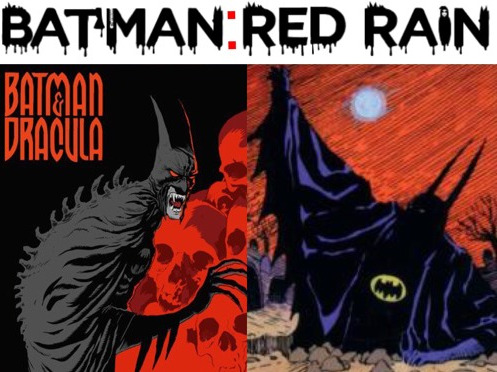
3. Dracula is one of the few public domain characters that I can’t help but say Marvel got better (except the stupid “Dark Elf” look where he had that high white pony tail and red armor from 2010 until 2018. That was annoying.) But no one can deny that Tomb of Dracula (which gave us Blade: The Vampire Hunter) is now a classic.
Come to think of it, I prefer Marvel’s Adam (The Frankenstein Monster) to DC’s Frankenstein monster too. At least when Marvel remembers Adam (The Frankenstein Monster) is intelligent and articulate. Sometimes he gets writers who are stuck on “Fiiire Baaaaad!” and clearly aren’t familiar with the Mary Shelley novel... (Someone hire Steve Niles, quick!)
4. On to the story itself. This scene. This scene right here! Bruce Wayne / Batman The Great Detective... He should not have had to write “Alucard” on a silver platter in lipstick and hold it up to a mirror to realize it’s Dracula spelt backward. I get that The Batman is the more kid friendly incarnation of the animated Batman but why not a scene of him telling someone like Alfred or someone else that Alucard is Dracula backward. Spare “The Great Detective” his dignity.
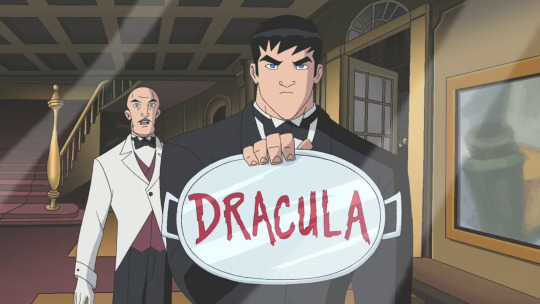
Also let’s be honest. Dr. Alucard is just a terrible alias and Dracula is just asking to be caught. And not just because he was overly excited by a platter of steak tartare. This Dracula is so obvious I think he wants to be captured. ...I think it’s a cry for help.
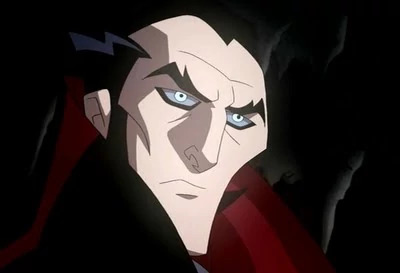
5. Dracula’s death scene. Batman in the main DC comics continuity and especially in the more kid friendly animated universe does. not. kill. Yet here in this animated movie (Tied to the “Kid friendly” The Batman animated series) has a scene of Dracula defeated and on his knees. And what does Batman do?:
Weak and on his knees Dracula looks up at him and goes “You’re Bruce Wayne.” (Someone clearly forgot one of Dracula’s powers is supposed to be mind reading! In fact I’m adding that next. The de-powering of Dracula.) Batman melodramatically has his cape spread in front of a giant sunlamp’s light. (No, really...) It briefly looks like Batman is going to show him mercy. Batman corrects Dracula by saying “I’m Batman.” And it’s a fairly cool delivery but then he lowers his spread cape so that the light kills Dracula. Who is cowering ON HIS KNEES! Our hero, ladies and gentlemen!
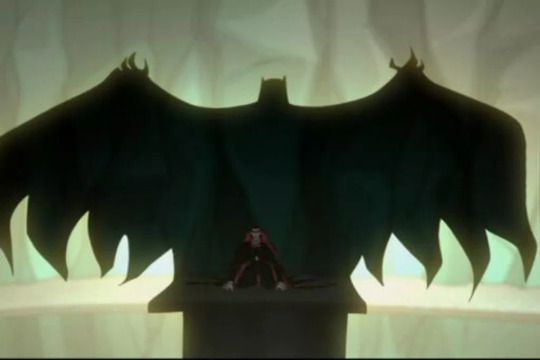
Questions and problems related to this:
A. Does killing Dracula not count as taking a life because he’s undead? Isn’t that some sort of racism, Batman? And if Dracula doesn’t count as alive where’s the line? Does that mean Solomon Grundy and Swamp Thing don’t technically count as alive? Grundy is literally a zombie. Swamp Thing is the consciousness of a dead man absorbed into “The Green” and in a plant-avatar body. Run, Swampy! Batman’s goin’ gardening!
B. Does this not count as murder because it’s technically the lamp that killed Dracula and not Batman? This is a dubious technicality. Again, where’s the line?
C. Honestly, based on how it played out, it looked like he WAS going to show Dracula mercy but once he realized Dracula knew his secret identity he decided to go “Nope.”
D. Even The Avengers don’t try to kill Dracula anymore. Marvel heroes have elaborate restraints and special cells for holding Dracula. If Tony Stark can do it, so can Batman. Wouldn’t Dracula’s blood addiction and predatory instincts and animal-like inclinations from an arcane blood mutation that grants superhuman powers earn him his own special cell at Arkham?
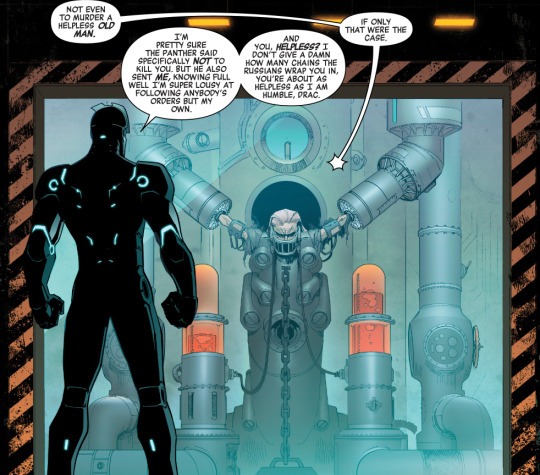
E. We saw at the start of The Batman vs. Dracula that Dracula had easily been held in chains in a coffin away from his homeland. So obviously he can be contained. Was Batman just being lazy? In Batman The Brave and the Bold we learn he has Nth metal handcuffs that can hold a ghost. He should be able to contain Dracula.
F. Come on! Dracula is easy to contain compared to The Joker yet The Joker is spared!
G. This was a missed opportunity. Think how interesting a recurring Dracula could have been. He could have escaped or been captured. And if he was captured a semi-reformed Dracula would make for a fun reluctant hero or anti-hero (So long as he keeps all of his powers, of course.) Imagine the banter if Bruce held him in The Bat cave.
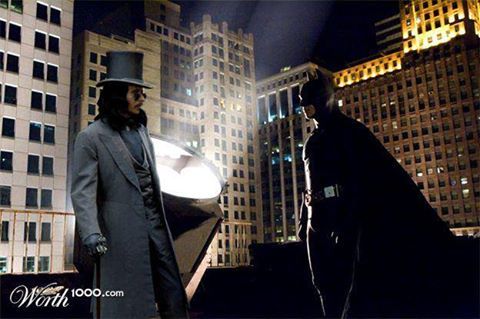
6. Dracula is too depowered. Marvel and DC are both guilty of making Dracula burn in the sun (like in the movies) but in the original Stoker novel Dracula could walk in the daylight just fine. He was just weaker by day because it was not his natural time. And he could not take animal form by day.
Marvel once published a graphic novel of the original Dracula story by Bram Stoker and in that they remember that Dracula could walk by day. And they claim the graphic novel is the backstory for the version of Dracula in Tomb of Dracula but by the time you get to Tomb of Dracula he burns in the sun. So go figure...
Anyway, Marvel’s Dracula has the power to conjure storms, turn into a wolf, bat, and mist. He has been raised from the dead many times. He can read minds. And he can hypnotize. Of course he has all the traditional weaknesses too but still this version seems far more powerful than DC’s Dracula...
Marvel’s dracula is just superior.
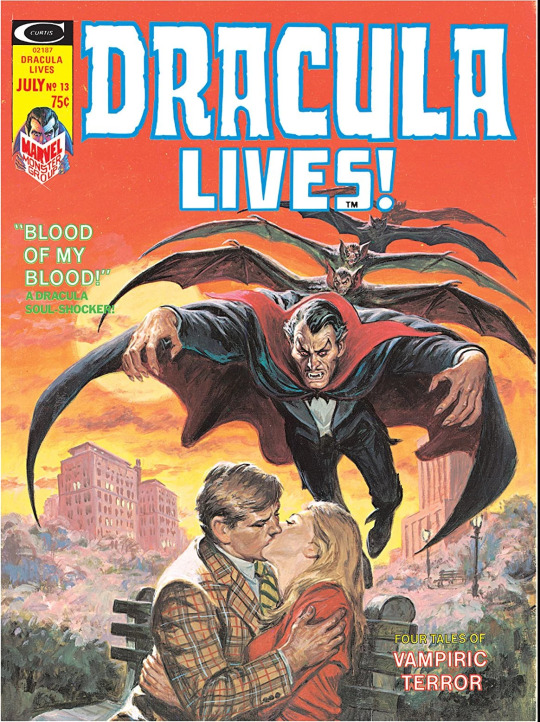
And what makes it more frustrating is Dracula is in the public domain. That means anyone can use him. And they could have and still could do so much more with him.
7. It’s a little odd that Dracula’s wife in The Batman vs. Dracula is Carmilla. Carmilla is a lesbian in her original novel. She’s bisexual in Castlevania. I don’t mind her being bisexual. And I don’t really mind this twist. It’s just a little odd.
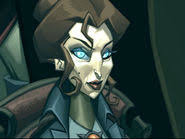
8. I keep wishing they would remake the animated movie but with a more serious / adult feel to it, like Justice League: Dark. And I wish DC was as good about finding clever uses for their Dracula as Marvel does. DC’s version goes to waste.

Just look how cool he looks! Why aren’t they using him?!
18 notes
·
View notes
Text
WIRED Book of the Month: It Came From Something Awful
Any page of It Came From Something Awful would be the most shocking page of most books. Reading Dale Beran’s chronicle of 4chan, the anonymous imageboard where some of the internet’s worst scandals have been fomented, feels like scrolling through the forum itself. Each page turn sucks you ever deeper into chan culture, from emoticon cats telling you to “Please die” to harassment campaigns levied at adolescent girls to a man describing how he murdered his girlfriend. “Turns out it’s way harder to strangle someone to death than it looks in the movies,” that man said, alongside images of the woman’s dead body. Eventually, in Beran’s aggrandizing telling, 4chan’s crescendo of furious nihilism delivers President Trump to America.
In 2017, Beran, a writer and cartoonist, published a Medium post titled “4chan: The Skeleton Key to the Rise of Trump,” which explained how a website started by a 15-year-old who was “bored and in need of porn” ended up churning out pro-Trump propaganda. The piece was unusual for its deep familiarity with and empathy for the desires of 4chan’s anonymous users. Beran used to be one of them. He was once young, aimless, broke, and interested in webcomics, which, during the late 1990s and 2000s, before 4chan was consumed by fascism and white supremacy, were the primary prerequisites to participation. Still, he felt “a little too old,” he writes in Awful, a book-length enlargement of the Medium piece, and seems to have been more sympathetic voyeur than active participant. He attended Anonymous’ anti-Scientology protest in Time Square in 2008—perhaps the first time 4chan came together offline en masse—but as a wannabe reporter rather than as a Guy Fawkes–masked agitator.
His voyeurism means he knew the right questions to ask, then and now. When a masked anon told him the protest was “serious business,” he saw layers most would miss. “‘The internet is serious business’ was a meme, a joke on 4chan,” he writes. “One that weev [a notorious neo-Nazi-aligned hacker] claimed he had invented. And so it went down the line: Anonymous protesters, all following Rule 1, trying to conceal 4chan from me, and obscure the source of the joke, just like a raid into a chat room, each hiding their motivations behind a mirrored chamber of repeated memes.” The amount of lurking required to see through this funhouse of references is prodigious—and rare among those who have not fallen through the looking glass themselves.
It Came From Something Awful, by Dale Beran Buy on Amazon
Macmillan
Naturally, Beran explores the psychology of young, disenfranchised masculinity that 4chan represents and the sociopolitical context that molded its minds, which is the book’s greatest strength. As Beran explains, many Gen Xers and millennials, raised to expect boomer-era prosperity, instead found themselves scuttled by the Great Recession: jobless or doomed to 1099-R subcontracting gigs, drowning in debt, unable to make real-world romantic attachments, slowly realizing that the future they’d been promised was canceled. At first, they escaped into the internet, into ’80s and ’90s references. The nostalgia drifted further back, becoming more twisted. Anons yearned for the 1950s, not just for its unionized jobs and for the “greatness of America” but also for the ability to call the cops on a black man and “watch as they beat him into a coma while sipping a Gimlet” and to “fuck my wife in the missionary position with no concern for her pleasure.” Prosperity and fascism, understood as one. The rise of the so-called alt-right in America, explained. It’s a more satisfying and complete answer than many others.
Beran understands the grotesqueries of 4chan as a kind of modern monument to disconsolate male heartbreak. Other eras have gotten yearning sonnets or the Taj Mahal; our time has given us misogynistic meme culture and boxes of My Little Pony figurines covered in lonely teenagers’ ejaculate. The joke with that latter example is that prospects are so grim that fictional characters are likelier romantic partners. The trouble, Beran argues, is that it’s not a joke anyone else gets. Or even a joke at all. “There’s no word for a farce of a farce. The story of anime to anime Nazi. Internet utopia to dystopia. Reality TV to reality. America to Trump,” Beran writes. “Time to pick up the pieces. I hope you laugh too.”
I did not laugh (or cry). Maybe that’s because 4chan can’t shock me anymore. I, like Beran, lurked there years before the website became weekly headline fodder. As a young teenager, I logged in because I wasn’t supposed to. I stayed to confirm my suspicions that there was something off about the way the world reacted to me—the old 4chan slogan, “tits or GTFO,” directed at any female person on the platform, cleared things up fast. I didn’t credit 4chan with inventing sexism then, just as I don’t agree with Deran’s multilayered title now (“it” refers to both 4chan itself—whose ethos originated with the predecessor site Something Awful—and Trump). 4chan didn’t meme Donald Trump into office. Its angry anons, like everyone else, are surfing the same economic and emotional tide that brought everyone to this moment. They’re just unsubtle and evangelist with it, and their sentiments are (somewhat) searchable. They’re as much a symptom as overweening progressive outrage culture is, rather than cause.
Still, while I think Beran gives 4chan a bit too much credit as world-shapers, I likely gave the site too little. When you’ve finished It Came From Something Awful, it’s hard to hold it all in your head. As the book pings from rickrolling to pedophilia, Milo Yiannopoulos to Tumblr, Berkeley brawls to Japanese internet forums, it leaves you with a more or less singular impression: 4chan’s tentacles encircle the world, undulating above and below public consciousness, electrifying culture whenever they break the surface. Not because they’re driving it, but because all they do is sit there, twitchily watching.
If Beran is a 4chan voyeur, he’s made me see 4chan as something like Voyeurs Anonymous. They feel isolated and powerless because they are. There’s a reason its most fervent users are teenagers, NEETS (that’s “Not in Education, Employment, or Training”), or both. In some cases, that distance has driven them to extremism, but it's also made them uniquely able to reflect the world back at the rest of us. It’s just the part of the world that, for a long time, everyone was pretending not to see, creating that vague Wrongness that drove me to 4chan in the first place. We’re franker about the state of the world now, and 4chan’s “lol nothing matters” spoofing is partly responsible.
To me, the most interesting idea in the book is one Beran only touches on: why some people could pull up from the smug, furious, post-truth hate that consumed 4chan in the last decade while others could not. Beran credits his narrow miss to his father’s experience with Nazis during World War II. (I’m not sure why I avoided the fate of women like the user Loli-Chan, who was groomed by trolls from a young age to trade sexual images for virtual currency. If middle school locker-room chat is to be believed, girls around me courted a similar fate.) In that question Beran and I are asking—why not me?—might be a solution, a way to snatch vulnerable people away from communities that will contribute to their radicalization. As it stands, all we have is 4chan, and books like It Came From Something Awful: grainy upchucks of memes and scandals and news items spattered across the internet, leaving stains of so many different partially digested ideas. We may never know which ones made us sick.
Further Reading
‘The Ambivalent Internet: Mischief, Oddity, and Antagonism Online’ by Whitney Phillips and Ryan Miltner If you’re still looking for more web weirdness, Phillips and Miltner explore strange internet artifacts—from #YesAllWomen to Boaty McBoatface to Donald Trump’s Twitter account—to understand the ways internet culture can both create community or destroy order.
‘The Revolution That Wasn’t: How Digital Activism Favors Conservatives’ by Jen Schradie Maybe hashtag activism, for all its flashiness and vaunted successes (the Arab Spring, #MeToo), doesn’t actually work. Schradie considers how conservative digital activism has achieved greater success IRL.
‘Troll Hunting: Inside the World of Online Hate and Its Human Fallout’ by Ginger Gorman If you’re still not sure about the difference between lols and lulz or online harassment and Russian meddling, Gorman will enlighten you in this deeply sourced, deeply personal account of digital aggression.
‘Status Update: Celebrity, Publicity, and Branding in the Social Media Age’ by Alice Marwick In the time between the dot–com boom and the App Store, Silicon Valley was coding the bones of the social media platforms that now shape our lives. Marwick explores why the democratic revolution many techno-utopians expected has yet to arrive.
‘(Not) Getting Paid to Do What You Love: Gender, Social Media and Aspirational Work’ by Brooke Erin Duffy You know you’re a woman in the gig economy when you’re expected to cheerfully work for free. Duffy’s research into the world of fashion designers, bloggers, and designers illuminates the gendered stakes of the collapsing creative economy.
Next Month …
Senior correspondent Peter Rubin will review Yoko Ogawa's The Memory Police, out in translation August 13.
When you buy something using the retail links in our stories, we may earn a small affiliate commission. Read more about how this works.
Related Video
Culture
Neuroscientist Explains ASMR's Effects on the Brain & The Body
ASMR, Slime, and other Oddly Satisfying videos are enormously popular online, but we know surprisingly little about the body's responses that keep us wanting — and watching — more. WIRED's Louise Matsakis spoke with psychologist and neuroscientist Nick Davis, who co-authored one of the first studies about ASMR.
Original Article : HERE ;
WIRED Book of the Month: It Came From Something Awful was originally posted by MetNews
0 notes